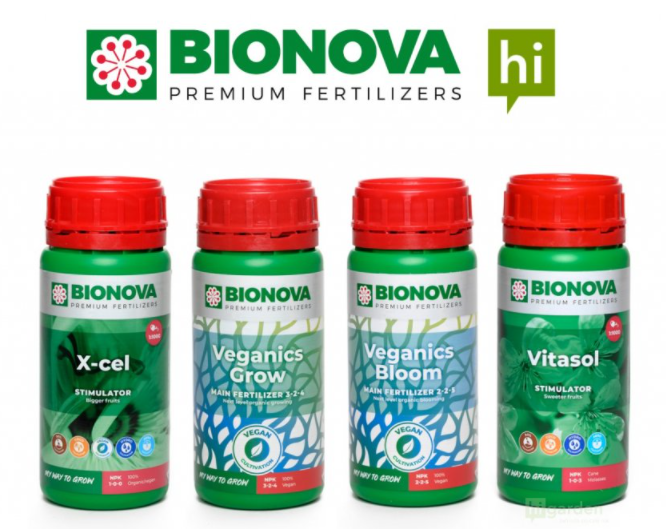If you asked us to name one thing which is the beginning and end of successful indoor and outdoor growing, we would unequivocally say it's fertilisers. Basic and supplementary fertilisers in the correct doses will significantly influence your next harvest. So choose wisely - nobody wants to grow sad plants which bear plain fruit. Don't hang your head: if you're smart about it, you won't have to spend a fortune to get the best quality.
Proper plant nutrition doesn't have to be rocket science. This article covers the fundamental rules of using fertilisers and their types.
Most fertilisers are liquid and added to the watering can or irrigation system. Once there is fertiliser in the water, we call it a nutrient solution. This solution is applied directly into the soil (or substrate), where the plant's root system absorbs it. Some fertilisers are used as a foliar spray.
When picking fertilisers, you should start with basic nutrition - NPK fertilisers. These contain the basic macronutrients (elements plants need in large quantities) nitrogen (N), phosphorus (P) and potassium (K). Fertilisers divide into types according to the growing media they will be applied in. So, according to the method and medium you're using, pick one of these options:
Fertilisers can be organic, mineral and biomineral according to their ingredients.
Organic fertilisers contain only purely natural ingredients like seaweed, manure, earthworm droppings and bat guano. They're perfect for classic indoor and outdoor growing in soil and coco substrates. However, we don't recommend using them in hydroponic and aeroponic systems. Organic fertilisers often contain larger particles which could clog the pipes. Furthermore, some already have a very natural smell and can go bad quickly - you really don't want something like spoiled FishMix in the nutrient tank. Mineral fertilisers are entirely artificial and based on inorganic substances. They're suitable for any growing media or method, except for (obviously) organic farming. Biomineral fertilisers combine the advantages of both worlds.
Out of organic fertilisers, we definitely recommend the BioNova Veganics complete nutrition, which includes basic fertilisers and top-notch supplements like Vitasol and the exceptionally powerful and 100% organic growth and bloom stimulator X-Cel Booster. We wrote an entire article about BioNova Veganics, which you can read here.

According to the number of elements, we further divide fertilisers into single-nutrient (straight) and multi-nutrient fertilisers. Single-nutrient fertilisers contain only one (macro)nutrient (like silicon or nitrogen), while multi-nutrient fertilisers contain more of them - for example, PK 13-14 or NPK basic (main) fertilisers. We also describe fertilisers according to the number of parts they have: one-component, two-component (A+B) and multi-component. One-component fertilisers are usually specialised for a growth phase, while multi-component and A+B fertilisers work during the entire cycle, and you just change the doses.
According to the plant's current growth phase, we use:
- fertilisers for the vegetative phase
- fertilisers for the flowering phase
- and fertilisers for the smallest plants - for seeds or clones and seedlings
Different plant types and species need different nutrition. The size of the planned crop also determines how much fertiliser you will need and if it isn't more economical to buy a larger discounted package. So plan ahead, set a goal and then buy fertilisers according to the exact needs of your garden.
Plant nutrition also includes two stand-alone sections which shouldn't go overlooked:
- Stimulators (also called boosters) support plant development. They focus on helping the plant create an extensive branching root system, support vegetative growth or encourage the plant to flower vigorously. Pick a root, growth or bloom stimulator according to your crop's current needs. Our customers are also quite fond of universal stimulators suitable for any growth phase.
- Protection against pests includes multi-purpose fertilisers with added herbicides or pesticides. If you're looking for a natural way to defend your plants, we recommend the BioNova NovaFoliar organic pesticide.

The last characteristic which defines fertilisers is their form.
Most often, fertilisers are liquid. They're easy to apply - simply mix them into irrigation water according to the feeding charts. Liquid fertilisers are suitable for substrates and inert growing media. They're used in all types of gardens, indoors and outdoors.
Solid fertilisers (in the form of tablets) are an alternative to liquid fertilisers. Solid fertilisers work in the long term and release nutrients gradually. They may be effective for up to 5 months.
Powdered fertilisers are another option. They work similarly to solid fertilisers - sprinkle them across the fertilised area or work them into the soil during repotting, and that's it.
TIP: You will achieve the best results if you combine fertilisers, supplements, additives and substrates from the same manufacturer!
We hope we have made choosing a fertiliser easier. Our e-shop has a wide array of options, so don't hesitate to contact us, and our professionals will help you pick and combine the ideal complete nutrition for your plants. We're looking forward to any questions you might have at info@higarden.eu.
